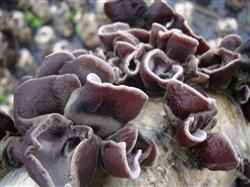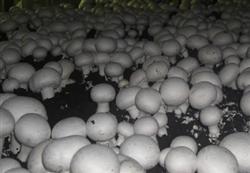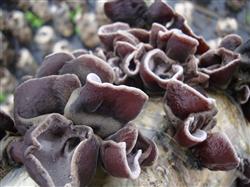Cultivation of Auricularia auricula with straw

After the autumn harvest, there is a large amount of straw left in the countryside, which is a great pity to be thrown away. The effect of cultivating Auricularia auricula with straw is very good, and it is also a way for farmers to get rich. The practice shows that in general, more than 10 kilograms of dry black fungus can be harvested per 100 kilograms of rice straw, and the high-yielding ones can obtain a net income of more than 200 yuan. The cultivation techniques are as follows: first, dry, fresh and mildew-free rice straw should be selected as raw materials; dry and fresh rice bran and wheat bran should be selected as auxiliary materials. Fertilizer can choose calcium superphosphate and gypsum powder, the former can be used to adjust the pH of the culture material, but also can provide phosphorus; the latter can be used to adjust the pH of the culture material, and can promote the mycelium to decompose nutrients. If the selected straw is planted in bottles, the straw should be cut into small segments about 3 centimeters long, soaked for 10 hours, picked up and set aside. If it is planted in a bag, the straw should be crushed and mixed with water before bagging to make the straw powder wet through. The proportion of culture materials for rice straw cultivation of Auricularia auricula is as follows: 66% of rice straw, 20% of rice bran, 10% of wheat bran, 1.5% of calcium superphosphate, 1% of gypsum powder, 1.5% of sucrose, plus 150 ml of Auricularia auricula yield enhancer and proliferation agent. The ratio of material to water is 1 ∶ 2. Bottle cultivation can use two layers of old newspapers, plus a layer of plastic film to cover the bottle mouth. Second, it is best to use large-mouth canned bottles for sterilization and inoculation, and the tools used should be strictly sterilized with 0.1% potassium permanganate or 3% Lysol or 75% alcohol. The inoculation box and inoculation room were fumigated with formalin; the culture room was sprayed with 0.3% bromogeramine and 3% Lysol aqueous solution. The culture material should be sterilized at a pressure of 1-2 kg for one and a half to two hours. If sterilized under atmospheric pressure, it should be kept for 10 hours after the water is boiled. The bags should be discharged layer by layer of paper in order to prevent overlapping extrusion from affecting the disinfection effect. After disinfection, when the bottle and bag are cooled to about 35 ℃, they should be moved into the inoculation room and inoculated in the inoculation box. Should be warm inoculation, culture bottle or put into the inoculation box, inoculation room, disinfect with formalin, potassium permanganate mixed disinfection, sealed for half an hour, and then disinfect hands and inoculation equipment with 70% rape 75% alcohol. When inoculating, the bacterial film on the surface of the bacteria should be removed, and the bacteria should be dug up and inserted into the bottle or bag. Each bottle of cultivated species can receive 45-65 bottles or 30 bags of straw culture material. The third is to send bacteria to stimulate the ear. Put the inoculated bottle or bag into the culture room, which can be stacked, but do not move much. The culture room is kept dark and clean and regularly ventilated. 1-6 days after inoculation, the temperature in the culture room should be controlled at 25-28 ℃, so that the mycelium of Auricularia auricula could germinate and colonize as soon as possible and reduce the pollution of miscellaneous bacteria. On the 7th-15th day, the room temperature dropped to 22-25 ℃, making the hyphae strong and strong, and humidity was generally not considered at this stage. After 30-40 days, the whole culture material can be covered with hyphae. Ten days after the mycelium is sent to the bottom of the bottle, the sealed newspaper or Kraft paper should be removed, leaving only a transparent film to bind the mouth of the bottle, and then pierce more than ten holes with a needle to promote ear bud growth. Then put the bottle horizontally on the ground and stack 7-10 layers. The bottle can also be moved to an outdoor ear field with shade facilities for ear management. When the culture material is full of mycelium, the oxygen should be permeated into the bag. At this time, the temperature of the culture room is 20-23 ℃, the relative humidity is 80%, and the inoculation of 0.5cm is used to punch several ear points around the bag, showing a zigzag distribution, with a distance of 5-6 cm. The oxygen in contact with the bag material is sufficient, and the mycelium development is accelerated. In order to promote ear growth, the bag can be covered with newspaper and sprayed with water to maintain 85% of the relative humidity of 90% of the bag material. Direct light should be avoided indoors to prevent the bag material from excessive evaporation. Fourth, ear management. When the fungus is as big as the soybean grain, remove the sealing film of the bottle and moisturize the ear. Generally, in the ear bud stage, the relative humidity of the ear chamber should be 85%, 90%, 90%, 95%, 90%, 95%, 90%, 95%, 95%, 95%, 95%, 95%, 95%, 95%, 95%, 95%, 95%, 95%, 95%, 95%, 95%, 95%, 95%, 95%, 95%, 95%, 95%, 95%, 95%, 95%, 95%. Spray water to "three look": look at the weather, spray less or even not spray when rainy, spray more when sunny and dry; look at the ear shape, small ears should spray less, spray less in the state of blisters, ears should be more dense and more spray; look at the temperature, when the temperature is above 25 ℃, you should give priority to heat preservation during the day, spray water at night; spray water in the morning and night above 20 ℃, and spray more during the day when 15 ℃ or so. And pay attention to the bottle, bag mouth can not accumulate water for a long time to prevent auricularia auricula autolysis, affecting ear production. 0.1% urea and 0.1% potassium dihydrogen phosphate solution should be applied in combination with water spraying when the temperature is above 15 ℃, and about 1.5% glucose solution should be applied below 15 ℃. Spray the fat liquid directly on the ear piece. After the first harvest, water spraying should be stopped for 5-7 days to restore the growth of hyphae. The management method is the same as what we introduced earlier, which needs to be combined with water spraying for fertilization. Fifth, the growing period of harvesting and processing Auricularia auricula is generally about 100 days. When the color of Auricularia auricula changes from deep to shallow, the ear piece unfolds, the edge is rolled inside, the ear root shrinks, the ear piece becomes soft, the flesh is thick and elastic, and the ventral side produces white spore powder. It should be harvested in a sunny day in time to harvest frequently and carefully to ensure the high quality and high yield of Auricularia auricula. Auricularia auricula can be dried in the sun or dried over a low fire. In order to prevent moisture regain, it should be sealed in a plastic bag and stored in a dry, ventilated, clean and pest-free warehouse.
- Prev

Cultivation of Agaricus bisporus with wheat straw and cow manure
Greenhouse Agaricus bisporus overwintering period generally refers to the winter solstice after the year to the next year Jingzhe this period. During this period, the hypha was in a very slow or stopped growth stage, and sometimes a few fruiting bodies were produced, but it was of little significance in production. According to the dry and wet degree of bacteria layer, two methods of dry overwintering and wet overwintering are adopted.
- Next

Cultivation techniques of Auricularia auricula without ear Base
Auricularia auricula is a popular edible fungus, which has the characteristics of easy cultivation, strong disease resistance, high economic yield, short production cycle and so on. The annual cultivation of the whole country has been stable at about 500 million bags. With the expansion of cultivation scale, there is a great difference not only in yield but also in quality. The author is in Sichuan Province, the main producing area of Auricularia auricula.
Related
- Fuxing push coffee new agricultural production and marketing class: lack of small-scale processing plants
- Jujube rice field leisure farm deep ploughing Yilan for five years to create a space for organic food and play
- Nongyu Farm-A trial of organic papaya for brave women with advanced technology
- Four points for attention in the prevention and control of diseases and insect pests of edible fungi
- How to add nutrient solution to Edible Fungi
- Is there any good way to control edible fungus mites?
- Open Inoculation Technology of Edible Fungi
- Is there any clever way to use fertilizer for edible fungus in winter?
- What agents are used to kill the pathogens of edible fungi in the mushroom shed?
- Rapid drying of Edible Fungi

